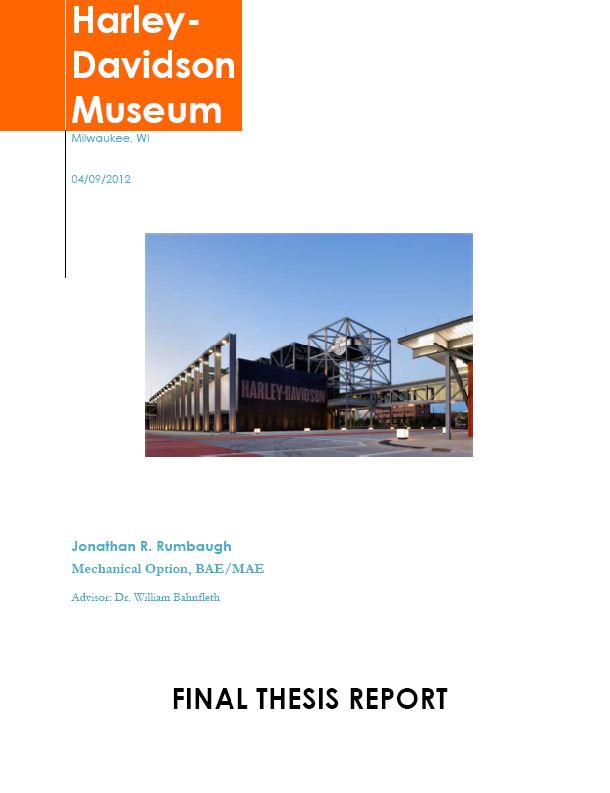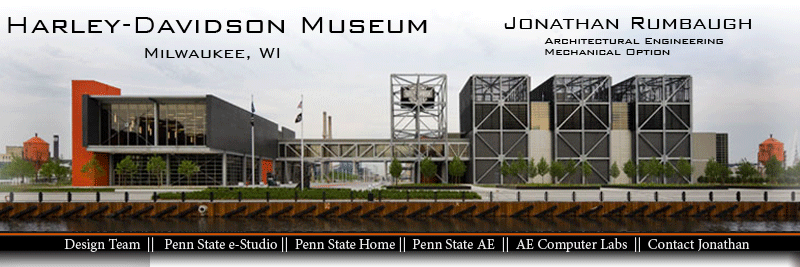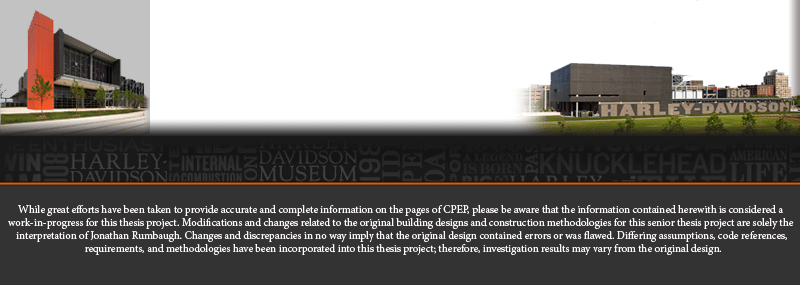 |

Click on the image above to view a pdf of the final thesis report. |
The final report for AE 482: Architectural Engineering Senior Thesis located at the left contains an analysis of the existing mechanical design for the Harley-Davidson Museum and the proposed redesigns and breadth topics. Studies focused on reducing thermal bridging through the structure, increasing efficiency of chilled water production by using the adjacent river for heat rejection, and becoming energy independent from the grid with combined heat and power. The report also includes two breadth studies, which are investigations into the structural system related to thermal briding and the electrical system related to combined heat and power. |
 |
EXECUTIVE SUMMARY
This thesis report was conducted on the Harley-Davidson Museum (HDM) in Milwaukee, Wisconsin. Separated into three distinct parts, the complex consist of a 60,000 SF Museum which houses the permanent exhibits; a 45,000 SF Annex Building which will accommodate temporary exhibits and Harley Davidson's extensive archives; and a 25,000 SF building which houses a 150-seat restaurant, a grab and go cafe, a retail space, and a special event space. The Museum has an exposed structure inside and
outside; furthermore, many of the interior areas did not permit ductwork to be visible which created a
challenge for the engineers at Hammel, Green and Abrahamson, Inc (HGA).
This thesis report discusses the topics, methods, and results that were investigated during a two semester study on the HDM. Investigations of the HDM existing design were conducted in the fall semester. The objective of the existing design investigation was to find areas that could be studied further in the spring semester and develop engineering and architectural design alternatives that prove to be more effective and efficient both economically and environmentally while being economically affordable. The spring semester was dedicated to the alternative analysis and extracting information from the study to form an in-depth thesis on building design and engineering.
This thesis is comprised of a three part depth analysis of the HDM mechanical systems and two breadth topics focused on electrical and structural engineering. The mechanical depth is an investigation into potential advantages of switching the existing air-cooled chilled water system to a water-cooled chilled water system. The study looks into two water-cooled alternatives. The first alternative is a conventional water-cooled system that utilizes a cooling tower as the means of heat rejection. The second alternative utilizes the river as the means of heat rejection.
In addition to the redesign of the mechanical system, two breadth studies were also conducted. The first breadth is an investigation on the application of on-site energy production and waste heat recovery, also known as combined heat and power or cogeneration. The study will investigate the feasibility of cogeneration at the Harley-Davidson Museum facility and will investigate the electrical design consideration such as the paralleled generator and utility connection.
The second breadth is an investigation of thermal bridging through the structural system. The structural system is currently designed with many areas of significant thermal bridging that could lead to wasted energy and mold growth. This breadth examines the benefits of implementing thermal breaks in the structural system compared to the existing solution of using heat trace. The thermal break will be investigated both thermally and structurally to determine if it is an adequate solution to the thermal
bridging problem.
- Mechanical Depth
Air-Cooled vs. Water-Cooled with Cooling Tower
Annual operating cost reduced by 5% [$7,159.00]
30 year LCC reduced 5% [$184,814.00]
Capital cost reduced 8% [$42,855.00]
- Air-Cooled vs. Water-Cooled with River Water
Annual operating cost reduced by 14% [$21,732.00]
30 year LCC reduced 10% [$389,986.00]
Capital cost increased 10% [$61,400.00]
Simple Payback 3 years
- Electrical Breadth
CHP Proven to be Feasible
Annual Savings of $140,000
CO2 reduction of 62%
Simple payback of 4.04 years
- Structural Breadth
Thermal break proven to support structural loads
Thermal break proven to be a successful solution to thermal bridging
Annual savings of $1,271.00 in main gallery space
|


